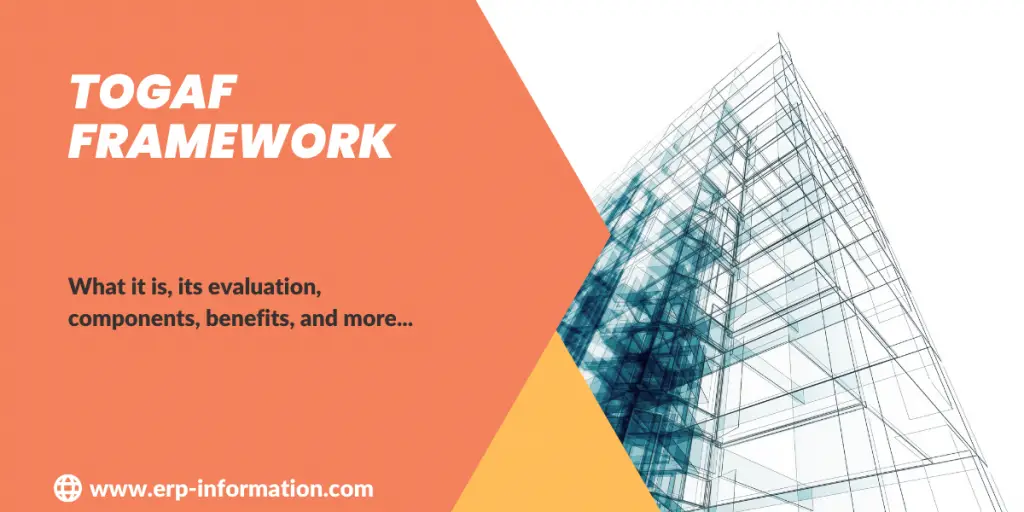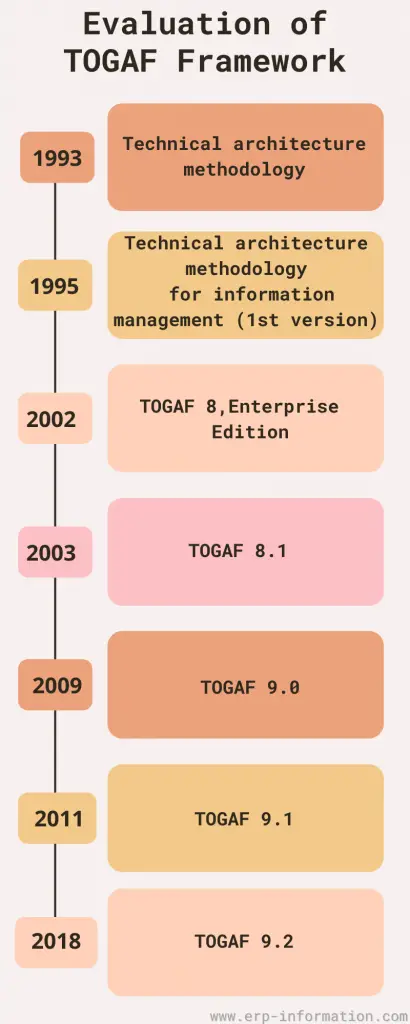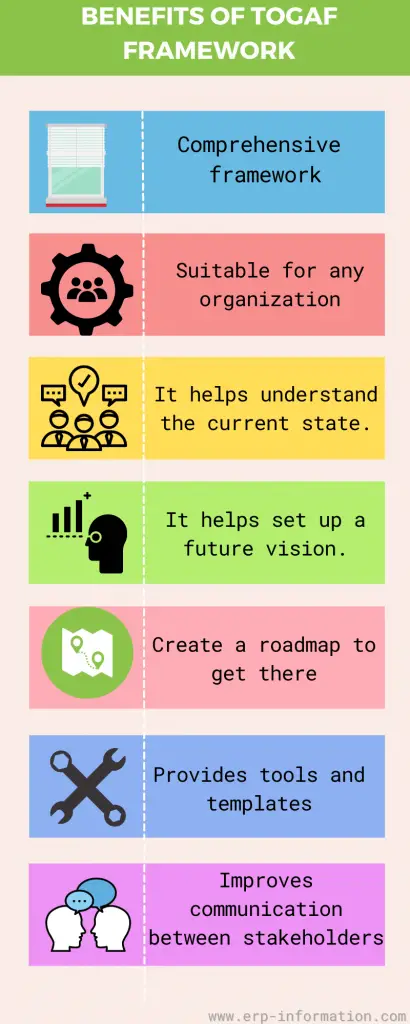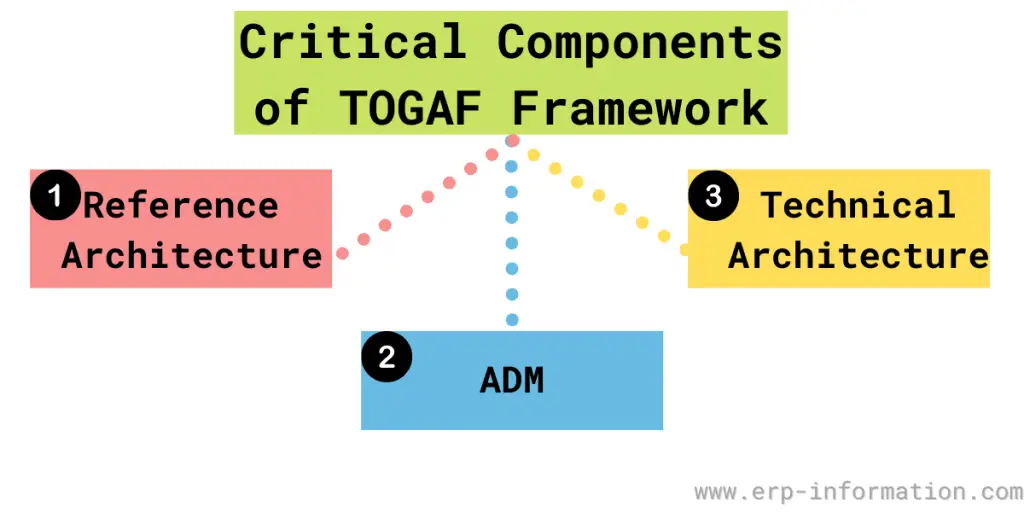Most organizations struggle with designing, planning, and implementing an enterprise architecture.
Implementing an enterprise architecture can be incredibly difficult and time-consuming. Many organizations lack the resources to do this effectively.
TOGAF is one of the enterprise architecture frameworks that allows organizations to design, plan, and implement their enterprise architecture more efficiently and effectively. This has been around since 1995, and nine different versions have been released.
This blog post will discuss the TOGAF in detail, including its evaluation, benefits, components, resources, and foundation exams.
The latest version of the framework is TOGAF 10. Released on 25th April 2022.
What is TOGAF Framework?
This is The Open Group Architecture Framework acronym, and it is an enterprise architecture framework that helps organizations design, plan and manage their enterprise architecture.
It is the most popular framework for enterprise architecture in the world. It’s been used by some of the biggest names in business, including Coca-Cola, IBM, Microsoft, and Oracle.
It is a comprehensive framework that can be used by any organization regardless of size or industry. It helps organizations understand their current state, identify where they want to go and create a roadmap for getting there.
It also provides tools and templates that simplify designing and implementing an EA.
Overview of TOGAF
The open group provides a free framework for organizations, but not for commercial purposes. Businesses should get certification from the open group for software, tools, and training sessions. Right now, eight certified TOGAF tools are available.
TOGAF certified tools
The open group listed eight certified tools.
- Avolution – ABACUS 6.0
- BiZZdesign – BiZZdesign Enterprise Studio
- BOC Group – ADOIT
- MEGA International – HOPEX Enterprise architecture Suite
- Orbus Software – iServer Business and IT Transformation Suite 2015
- Planview – Capability and Technology Management
- Software AG – Alfabet
- Software AG – ARIS 9.0
- Sparx Systems Pvt. Ltd – Enterprise Architect
TOGAF launched its 10th edition, which helps businesses by providing more guidance and navigation while implementing the TOGAF framework.
Organizations use the open group architecture framework to align IT goals with business goals. The new version uses a modular structure and helps implementation of the framework in all industries.
TOGAF is divided into two categories. One is TOGAF fundamental content, and another is TOGAF series guides. Fundamental content contains core concepts and best practices of TOGAF, which is the foundation for the framework.
The series guides contain guidance for the configuration of particular topics like business architecture, agile methodology, security architecture, and information architecture.
TOGAF Standard
| Fundamental Content | Series Guide |
| Introduction and Core Concepts | Business Architecture |
| Architecture Development Method (ADM) | Information Architecture |
| ADM Techniques | Security Architecture |
| Applying the ADM | Enterprise Architecture/Agile Architecture |
| Architecture Content | Enterprise Architecture/Digital Enterprise |
| Enterprise Architecture Capability and Governance | Technology Architecture |
| MSA/SOA Architectures | |
| Adopting the ADM |
Evaluation
Let us look at the evaluation of the framework.
The Open Group Architecture Framework is based on TAFIM (Technical Architecture Framework for Information Management).
In the 1990s, the US Department of Defense developed an IT management framework. That is TAFIM. It provided insights into DoD’s internal technical infrastructure.
In 1993’s technical architecture methodology is released.
In 1995’s technical architecture methodology for information, management was released as TOGAF.
In 2001, TOGAF 7 was released as a technical edition, and in 2002, TOGAF 8 was released as an enterprise edition.
It is updated to version 8.1 in the year 2003.
In 2005, TOGAF was taken over by The Open Group and released version 8.1.1 in 2006.
In 2009’s version 9.0 was released with increased guidelines and techniques. Version 9.1 was released in 2011, and the latest version is 9.2.
Benefits
Comprehensive framework
This is a framework, not a method or a process. It is an architecture development methodology that includes best practices, guidelines, and tools for developing enterprise architectures; it lays down uniform principles to follow when building your architecture.
The TOGAF ADM (Architecture Development Method) helps you develop your architecture – it is a step-by-step approach to developing an enterprise architecture and can be tailored according to project requirements.
Suitable for any organization
This framework is suitable for any organization – from small businesses to large enterprises.
It can be customized to fit the specific needs of your organization. It provides a flexible and scalable framework that can grow with your business.
Helps to understand the current state
It helps you understand the current state of your enterprise architecture to determine where it needs to be improved.
In addition, it allows you to identify areas for improvement and new growth opportunities.
Helps set up a future vision
It helps create a vision of your organization’s future state. This process includes identifying opportunities and defining goals that need achievement.
Creates a roadmap to get there
It helps you create a roadmap to get from the current state of your organization’s architecture to its future vision. This includes identifying projects and activities that need implementation to achieve this goal.
Defines goals, results, and measurements along the way
This guides how you can define goals, outcomes, and measures to ensure that you are on track to reach your final destination.
Provides tools and templates
It provides several tools and templates that you can use to help with your architecture development.
These include the TOGAF Architecture Repository, a collection of reusable assets for building enterprise architectures. This framework also provides guidelines on how to use these tools effectively.
Improves communication between stakeholders
It improves communication and understanding between all stakeholders involved in architecture development – from project managers to business analysts and architects themselves.
That ensures everyone is working towards achieving their goals by following this framework’s best practices for architecture development.
What are the Critical TOGAF Components?
The key elements include the Reference Architecture, the ADM, and the Technical Architecture.
Reference Architecture
It explains how an organization’s enterprise architecture should be structured and organized.
This includes guidelines on how to design and implement your specific applications in TOGAF and how they should relate to one another within its framework for enterprise architecture development.
ADM
It is the process that organizations use to design, plan, and manage their EA.
TOGAF lays down a set of step-by-step procedures that you can follow to develop your architecture, which helps ensure that all stakeholders are on the same page and working towards the same goal.
You can adapt and customize ADM to specific business needs.
Technical Architecture
It specifies the technologies and standards an organization should use in its IT infrastructure.
In addition, the framework defines some reference models for different technical architectures, which help organizations understand their options and make informed decisions about their IT infrastructure.
Resources you should check out
If you want to learn more about this framework, here are some great resources to check out:
– The TOGAF Standard 9.2 specification
– The TOGAF 9.2 Foundation Study Guide
Foundation exam
The Foundation Exam is a certification exam that tests your knowledge of TOGAF 9.2. The exam has 40 questions, and you have 75 minutes to complete it. To pass the exam, you must score 60% or higher.
FAQs
What modeling techniques does TOGAF use for enterprise architecture development?
TOGAF employs techniques such as the Architecture Development Method (ADM), Business Process Modeling, Data Modeling, and Application and Technology Architecture.
Conclusion
In this blog post, we’ve looked at what TOGAF is and its benefits. We’ve also looked at the standards, critical components, and resources you can use to learn more about it.
Reference



